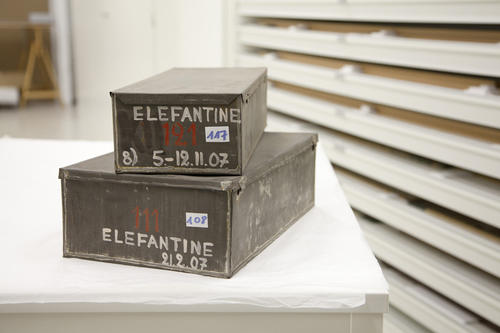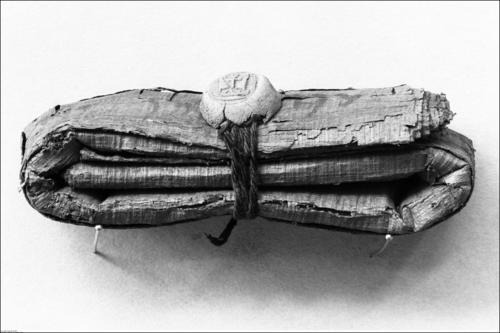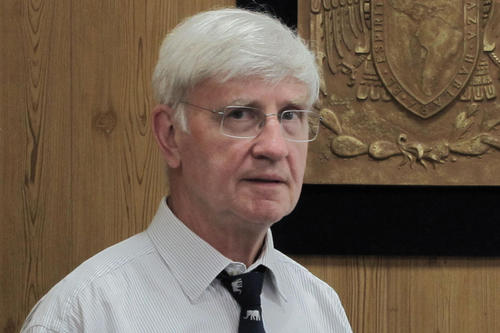A Virtual Journey into Antiquity
Physicist Heinz-Eberhard Mahnke is using scientific methods to help Egyptologists in Berlin decipher Egyptian papyrus manuscripts
Jul 14, 2015
The Elephantine find boxes from 1907 contain Aramaic papyri that are slated to be studied as part of the project “Localizing 4000 Years of Cultural History. Texts and Scripts from Elephantine Island in Egypt.”
Image Credit: Staatliche Museen zu Berlin, Ägyptisches Museum und Papyrussammlung, Sandra Steiß
Most of the papyri are folded or rolled together and difficult to open. Heinz-Eberhard Mahnke has found a way to make the writing visible anyway.
Image Credit: Staatliche Museen zu Berlin, Ägyptisches Museum und Papyrussammlung
Heinz-Eberhard Mahnke is an adjunct professor of physics at Freie Universität.
Image Credit: Instituto de Fisica UNAM Mexico
Countless treasures are tucked away in the Ägyptisches Museum und Papyrussammlung (Egyptian Museum and Papyrus Collection) in Berlin. Some of the pieces are on display in the museum’s exhibits. But many precious items are still waiting to be “unlocked”: The inscriptions on many papyri that were brought to Berlin in crates long ago have remained a mystery even to scholars. Some of them have been rolled up or folded together for millennia, so the experts only dare to disturb a few selected pieces.
There is great risk of damaging or even destroying valuable artifacts of an advanced civilization. But there are gentler methods, as Heinz-Eberhard Mahnke has shown. Mahnke, a physicist, has developed a method of unfolding papyri virtually. He is currently using this method to help Verena Lepper, an Egyptologist and the curator of the papyrus collection, as she works to decipher the finds from the Nile island of Elephantine – with initial successes.
About eight years ago Mahnke came up with the idea of using methods drawn from the natural sciences to make the Egyptian characters visible, when he heard a talk given by Berlin-based restorer Myriam Krutzsch. Krutzsch, who works for the papyrus collection of the Egyptian Museum, showed a tomogram – a “slice” image – of a papyrus packet. “You could see something was inside it,” Mahnke says. “Even back then, the question came up of whether it wouldn’t be possible to increase the resolution to the point that the script on the papyrus could be deciphered,” he continues.
Image resolution will be crucial if scholars want to be able to make out what is written on the papyrus, says Mahnke, who is currently an adjunct professor of physics at Freie Universität Berlin and previously worked at the Helmholtz-Zentrum Berlin für Materialien und Energie (HZB). “The ink applied to the paper isn’t as thick as in an oil painting, for example,” he points out. This means it is not possible to visualize the thin lines using a conventional medical tomography system. However, Mahnke says there are special units that can do the job. “Another thing that is needed is sharp contrast so that details become apparent in the image – like in an X-ray image of the human body,” Mahnke explains. “Bones or teeth stand out sharply from the rest, while tissue is not as easy to see. The situation with the papyri is similar.”
Ink That Contains Metal Is the Key to Success
For Mahnke’s approach to work, this means the first step is for the basic conditions to be correct. In particular, sufficient contrast is present when the inks used contain metal, he says. These pigments show up differently in an X-ray image than ink made with soot, for example, which cannot be captured at all so far.
In the ancient world, ink that contains metal could be produced from substances such as oak galls – apple-like growths found below an oak tree’s leaves in the fall. The galls form when wasp species such as Cynips quercusfolii lay their fertilized eggs on the tree. “This ink contains iron atoms, among other things – hence the name ‘iron gall ink,’” Mahnke explains. “But it did not come into widespread use in ancient Egypt until relatively late – starting around the first century A.D.,” he says. Other substances used as ink contained copper or mercury, and in some cases even lead, which can also be visualized well in tomographic images.
Since taking tomographic images of papyri is quite laborious and time-consuming, Mahnke says, a method known as X-ray fluorescence analysis must be used beforehand to determine whether there is any metal at all in the ancient manuscripts and finds. “If so, we can make several virtual sections and projections of the object,” he explains. This produces a three-dimensional representation. Mathematical unfolding and reconstruction can be used to distinguish the individual sheets and layers of lettering from each other, the scientist says. The end result is two-dimensional images with recognizable script.
Deciphering Manuscripts from the Nile Island of Elephantine
Heinz-Eberhard Mahnke and Verena Lepper, an adjunct professor of Egyptian and Oriental papyri and manuscripts at Humboldt-Universität zu Berlin and a member of the Egyptology Seminar at Freie Universität Berlin, now aim to use this method to examine an extensive find from the Nile island of Elephantine, which is rich in historic artifacts. Deciphering these valuable written materials is hugely important to Lepper’s work. She recently received an ERC Starting Grant from the European Research Council for the research project “Localizing 4000 Years of Cultural History. Texts and Scripts from Elephantine Island in Egypt.” She will have a total of 1.5 million euros at her disposal for the project over the next five years.
For a project like this to succeed, all three professions have to work closely together. Mahnke says, “First the Egyptologist reports an interesting find. The physicist looks for an appropriate way to study the find. And the mathematician or computer scientist helps translate the data into an image that people can work with.”
So far, Mahnke and Lepper are still in the early days of their high-tech journey into the world of ancient manuscripts. But Mahnke is confident. “Sooner or later, it will be possible to use a similar method to examine even papyri that are inscribed with ink that does not contain any iron,” he says. There have already been initial successful attempts in this direction.
Further Information
- Heinz-Eberhard Mahnke, Adjunct Professor of Physics, Department of Physics, Freie Universität Berlin, Email: heinz-eberhard.mahnke@topoi.org
- Verena Lepper, Adjunct Professor, Egyptology, Department of History and Cultural Studies, Freie Universität Berlin, Email: v.lepper@smb.spk-berlin.de



